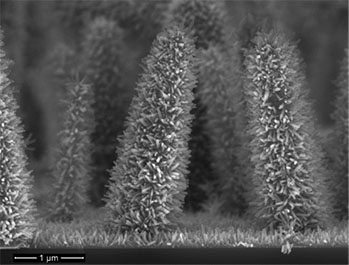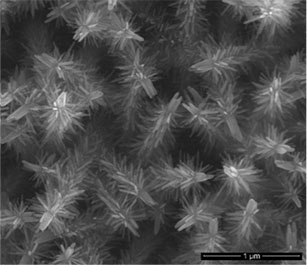BY BRANDON PATTERSON AND MARC T. HENRY DE FRAHAN


In a single day, enough sunlight strikes the earth’s surface to power civilization as we know it for over twenty years. Despite our best efforts to harvest the sun’s rays, the dream of a bright, solar-powered future still looks like a distant tomorrow. Part of the problem with current solar panels is that the Sun does not shine 24 hours a day. And when the sun sets, the lights go out. This is exactly the problem that Mechanical Engineering PhD Student Ashley Bielinski is trying to solve. Bielinski wants to take the energy from the Sun and, instead of directly producing electricity as is usually done, aims to convert the energy into a storable fuel. This is similar to photosynthesis, the process that plants use to make chemical energy from sunlight.
Bielinski hopes to create a storable fuel by harnessing the energy from the Sun to power chemical reactions. Bielinski uses a carefully engineered material that splits water (H2O) into hydrogen and oxygen when struck with sunlight. This hydrogen can be used as a fuel. But these chemical reactions are not particularly efficient. In order to make a useful amount of hydrogen fuel, she needs a large interaction area between the sunlight and the chemical. She is accomplishing this by using nanotechnology to create tiny structures capable of trapping and absorbing as much sunlight as possible.
These structures are like tiny trees, and about one thousand times smaller than a human hair. Similar to actual trees, her structures have a trunk with many secondary branches splitting off and smaller structures coming off of those. For the sun powered chemical reactions to occur, these structures need to be coated in Bielinski’s chemical. The structures are exposed to chemical vapors such that every nook and cranny is left with a thin film coating of the chemical. This allows Bielinski to maximize the reaction area between the sunlight and the chemical, so that more hydrogen fuel is produced.
There is still a lot of research left before this technology is out in the world, our homes, and our cars, but it’s a great step forward toward a bright, sunny future.
Ashley Bielinski’s advisor is Assistant Professor Neil Dasgupta and she is part of the Dasgupta Research Group.
